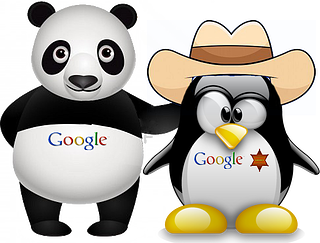 In 2014, there were a lot of changes made within Google’s algorithm, especially with Penguin and Panda. These have had the most effect on website’s rankings since, still well into 2016. The Panda update is a filter that is designed to penalize “thin” or poor content from ranking well. Whereas Penguin is a filter that is designed to penalize websites that have bad link building techniques and keyword stuffing. Throughout this post, I will explore each of these penalties a little more and create a timeline of their history.
In 2014, there were a lot of changes made within Google’s algorithm, especially with Penguin and Panda. These have had the most effect on website’s rankings since, still well into 2016. The Panda update is a filter that is designed to penalize “thin” or poor content from ranking well. Whereas Penguin is a filter that is designed to penalize websites that have bad link building techniques and keyword stuffing. Throughout this post, I will explore each of these penalties a little more and create a timeline of their history.
Penguin Updates
The most recent Penguin, that took alomost 2 years to hit, update had caused quite a disturbance among SEO experts. This is mostly because the rollout was chaotic and clumsy. For some businesses, this update was welcomed, especially from those that were hit by previous updates, but for other businesses, this update had a negative effect on their website traffic and rank, which could cost them business.
Penguin Update Timeline
- Penguin 1.0 – April 24, 2012
- Penguin 1.1 – May 26, 2012
- Penguin 1.2 – October 5, 2012
- Penguin 2.0 – May 22, 2013
- Penguin 2.1 – October 4, 2013
- Penguin 3.0 – October 17, 2014
- Penguin 3.1 – November 27, 2014
- Penguin 3.2 – December 2, 2014
- Penguin 3.3 – December 5, 2014
- Penguin 3.4 – December 6, 2014
- Penguin 4.0 – September 23, 2016
As you can see, Google updated Penguin more frequently in the beginning days of December, 2014, and then took about 2 years for the long-awaited Penguin 4.0 to hit. Once it was released, Google announced that this will likely be the last major Penguin update, because now this update will now be real-time and is baked into its core algortihm. In addition, this part of the algorithm is now more granular, which means that they now have the ability to either penalize the entire domain or just parts of it.
If you are worried about getting hit with the continuous Penguin update, a good first step is to look through your backlink profile once a month and remove anything that could negatively affect your rankings.
Panda Updates
As stated above, Panda is a filter that penalizes websites with bad, thin content. If you were hit by Panda 4.0, hopefully you updated your content to make sure it is original, noteworthy, and long enough to be considered useful.
Panda Update Timeline
- Panda Update 1 (Panda 1.0) – February 24, 2011
- Panda Update 2 (Panda 2.0) – April 11, 2011
- Panda Update 3 – May 10, 2011
- Panda Update 4 – June 16, 2011
- Panda Update 5 – July 23, 2011
- Panda Update 6 – August 12, 2011
- Panda Update 7 – September 28, 2011
- Panda Update 8 (Panda 3.0) – October 19, 2011
- Panda Update 9 – November 18, 2011
- Panda Update 10 – January 18, 2012
- Panda Update 11 – February 27, 2012
- Panda Update 12 – March 23, 2012
- Panda Update 13 – April 19, 2012
- Panda Update 14 – April 27, 2012
- Panda Update 15 – June 9, 2012
- Panda Update 16 – June25, 2012
- Panda Update 17 – July 24, 2012
- Panda Update 18 – August 20, 2012
- Panda Update 19 – September 18, 2012
- Panda Update 20 – September 27, 2012
- Panda Update 21 – November 5, 2012
- Panda Update 22 – November 21, 2012
- Panda Update 23 – December 21, 2012
- Panda Update 24 – January 22, 2013
- Panda Update 25 – March 15, 2013
- Panda Update 26 (Panda 4.0) – May 20, 2014
- Panda Update 27 (Panda 4.1) – September 25, 2014
- Panda Update 28 (Panda 4.2) – July 17, 2015
In March of 2013, Google came out with Panda "Everflux," which stated that, just like Peguin, the update is now integrated within the basic algorithm and is being updated constantly.
Conclusion
There have been many Panda and Penguin SEO updates throughout the years and now they will be more frequent than ever. Just remember to update your link building tactics and backlink profile accordingly to avoid a penalty. In addition to that, make sure you are updating your content and keeping it fresh, original and not thin.
Image credit: Moz.com

